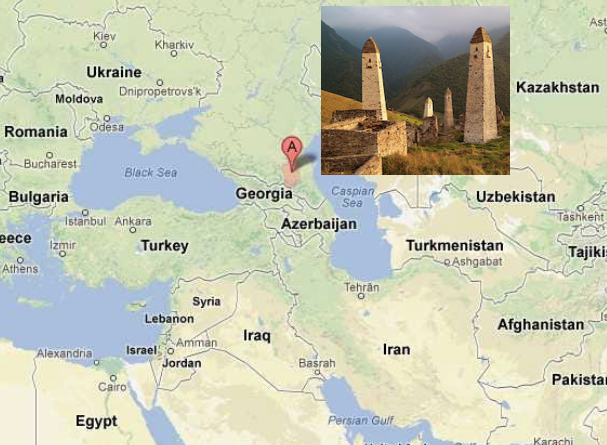La Defense Speakers of Chechen sometimes have difficulty reading and writing their own language. Currently there are about 1.4 million Chechen speakers, mostly in the Caucasus, but also in scattered colonies in the eastern Mediterranean, western Russia, and Bavaria/Tirol. The Chechens live in the mountains, in a linguistically diverse region that includes some very old languages.
In July 2018, I posted a blog on Tischlbong, a Slavic/Bavarian blended language spoken in the village of Timau on the Bavaria/Italian border. This blog takes us further east, to the region between the Black and Caspian seas, where a surprisingly diverse group of languages, some of which are nearly extinct, are still spoken in cultures that are thousands of years old.
It was actually the Azerbijani language that attracted my attention first, for a number of reasons, but after I began to appreciate the diversity of languages in this region, I learned of some unusual aspects of Chechen and decided to look into this, as well.
Chechen and Nearby Languages

Ubykh, one of the languages in the Akbhaz-Circassian language group, became extinct in 1992. This remarkable language had 82 consonants and only two vowels (Coene, 2009).
In general, minority languages and even some of the majority languages in the northern Caucasus region did not have their own alphabets until the 19th and 20th centuries. Chechen has a longer written history than most of the minority languages. Some of the minority languages are spoken by only a few thousand people and may be gone in a generation or two.
The Avar or Azerbaijani languages are used bilingually for economic transactions by a number of people in this region. Russian is also spoken and mandated in some areas.
In some ways, the Caucasians and Basques have characteristics in common. Not in terms of their language specifics or background (although both languages are agglutinative), but in resistance to outside influences. This is largely due to cultural isolation—mountain strongholds are harder to conquer. Historically, these cultural groups retained a certain autonomy that is reflected in their languages.
More recently, however, technology, Soviet expansion, and wars have left their mark and have wiped out a sizable portion of native literature. When orthography changes, books in previous alphabets become obsolete and are destroyed. With them goes the link to ancestral history.
History and Orthography
Chechen and Ingush are related to Vainakh, a northeast Caucasian language.
Like several middle eastern and central Asian languages, Chechen exemplifies synchronic digraphia—a language written with several alphabets, usually Arabic, Cyrillic, or Latin. Historically, the Arabic alphabet was used for Chechen, but since 1862, a Cyrillic-based alphabet was the dominant script, with recurring and politically controversial attempts to convert to Latin. In 2002, the Russian language was mandated for education, which may threaten the future of numerous local languages.
Members of the Chechen diaspora who settled in Bavaria and the eastern Mediterranean sometimes use Latin characters because they are familiar, but their efforts are not standardized. The number of books published in Chechen is small and some of these were destroyed in recent wars.
Chechen literature has received very little study but is worthy of attention because of its unique poetic characteristics and the position of this region in an important crossroad between Christian and Muslim cultures.
Some Interesting Aspects of Chechen
Chechen is an agglutinative language with some interesting characteristics. Literacy levels were not historically high, so it is difficult to chart changes between current usage and older versions of the language.
Here are some general characteristics…
Numbers (in the singular) and names of the seasons usually end in a vowel. Dal is the word for God, Seli for the traditional thunderer, and Eter for the ancient underground god (the Chechens were traditionally polytheistic).
There are many words comprised of simple 2- or 3-letter syllables, and some that repeat a syllable, such as zaza (flower), or which repeat a consonant together with different vowel or vice versa, as in or qoqa (dove) or adam (person).
Letters like j tend to be at the beginnings of words.
One spelling can have different pronunciations and serve multiple purposes. To take an example cited by E. Komen, the single word деза (deza) can be interpreted as four very different concepts:
dieza (to love), deza (valuable), diexa (to request), and deexa (long)
Does it look like Voynichese?
No, there is more variety in the positions of letters within Chechen words than in VMS tokens. But it demonstrates that natural languages can have orthographies in which different sounds are represented by the same shape, where vowel representation is limited, and within which the same linguistic unit can be repeated several times with different meanings for each iteration.
J.K. Petersen
© Copyright September 2020 J.K. Petersen, All Rights Reserved
